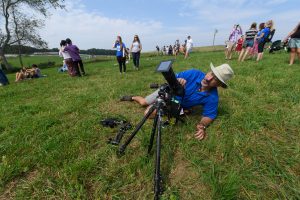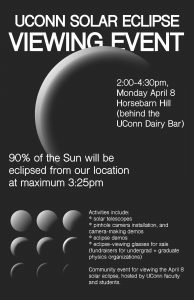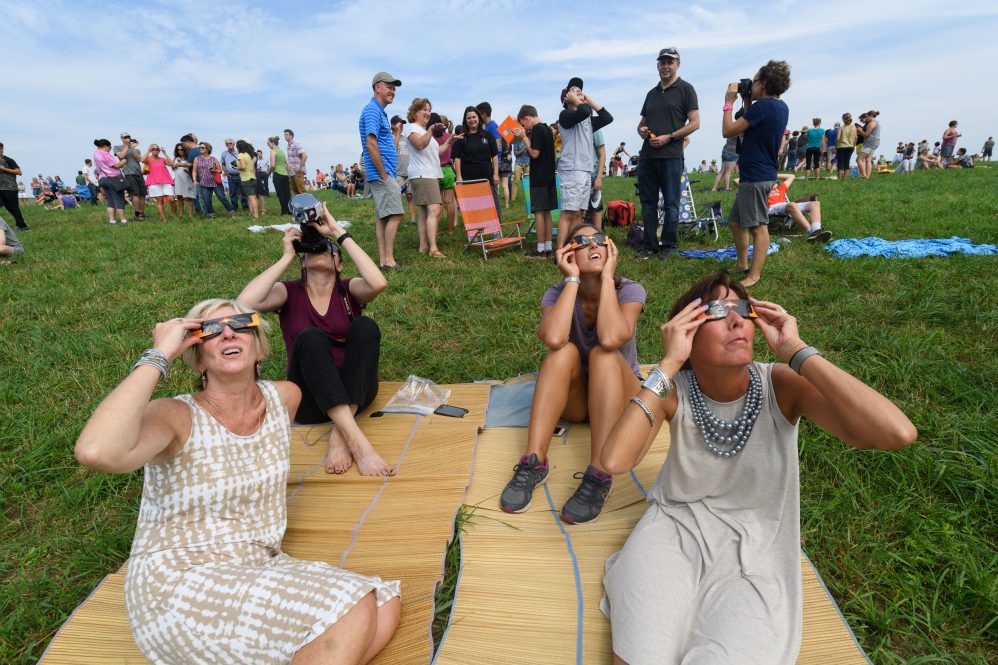On Monday, April 8, people across the country will experience a solar eclipse, with the northernmost portions of the northeast in the “path of totality,” where a total eclipse will be visible. Connecticut is not in that path, but we can expect around 75-90% of the sun will be eclipsed at UConn’s location, and to mark the occasion, the UConn Department of Physics is planning a viewing party which will take place on Horsebarn Hill just behind the Dairy Bar.
The viewing party is another example of the department’s rich history of outreach and engagement, where researchers and students share their love and enthusiasm for the subject.
If you plan to attend the viewing party
People who attend the viewing party should be respectful of the space, which is not a lawn. The fields on and around Horsebarn Hill are used for hay production to feed UConn’s farm animals. As part of a working farm, the fields support UConn’s teaching, research, and service mission. It’s important that visitors tread lightly and pick up any trash so the hay can be harvested and provide feed for UConn’s dairy and beef cattle, sheep and horses.
“As an astronomer, I’m a physicist, but I think a lot of us astronomers like to think of astro as the gateway to physics,” says Associate Professor Jonathan Trump. “My colleagues joke that the number of words I have to say before somebody gets excited about what I do is much shorter than their number of words. All I have to say is ‘black holes,’ and there, it’s just two words.”
No matter the physics subject, Trump says that people have always been interested in understanding the world around us.
“We have been looking up at the stars and trying to figure out the motion of the Earth, which causes days and seasons and things like this, for thousands of years. There is a well-established interest in trying to understand physics. I like to use astronomy as the hook for that.”

And eclipses are excellent hooks. In 2017, another eclipse viewing party attracted an estimated 2,000 people to Horsebarn Hill, where physics faculty and students led activities and helped viewers learn more about the astronomical spectacle taking place in the sky.
Absent major astronomical happenings like eclipses, the physics department regularly hosts events, from Astronomy on Tap to outreach for local school children. Trump says for the past few years, he has hosted astronomy nights for the Cub Scouts on Horsebarn Hill once a year with the help of the undergraduate astronomy association. Now with the East Road Observatory and soon the planetarium both back up and running, there are hopes to do even more of these kinds of activities.
The observatory and planetarium are tools for teaching both UConn students and the surrounding community about astronomy, and the late Professor Cynthia Peterson was an enthusiastic advocate for educational outreach and dedicated much of her time to such efforts. Peterson is remembered for her generosity in sharing her knowledge and love for the subject and serves as an inspiration for others to carry on the legacy.
Associate Professor Jason Hancock says Peterson’s outreach efforts still inspire him. In March, Mansfield Elementary School second graders visited UConn in an event organized by Hancock. Researchers and graduate students showed enthusiastic elementary schoolers experiments illustrating different aspects of physics like optics, energy, and resonance. With lots of hands-on opportunities, everyone in attendance, including teachers and chaperones, had a chance to get involved with science and the atmosphere was full of wonder and excitement.
“With the March MES field trip, we were aiming to provide seven and eight-year-olds an opportunity to experience aspects of modern science in an exciting and memorable context, to not only inspire but to inform,” said Hancock. “We made an effort to put together an age-appropriate curriculum from national second grade STEM standards and used our studio physics course structure and experience to set up a kind of museum of science right here in Storrs.”
Volunteers from the department came from all levels of experience, from undergraduates to department heads, participating shoulder-to-shoulder in an organized environment where very young kids could ask questions to expert and aspirant scientists at UConn. “This was the largest such event we have hosted, and it wouldn’t be a success without the help of the graduate and undergraduate volunteers, instructional staff, faculty, and teachers. Together, we carry on the important work of Cynthia Peterson and others in a long tradition of outreach activities.”
Academic Assistant David Perry ’87 MS ‘96 Ph.D., who Hancock says has been another perennial driving force behind outreach in the department, treated the MES students to a liquid nitrogen show, where frozen flowers were smashed, balloons were shriveled, and concepts of thermal expansion and density were put in real live context to an accessible narrative. Dave used liquid nitrogen to shrivel and shrink balloon sculptures of a UConn Husky (i.e. traditional blue balloon dog) and a Mansfield Elementary Tiger to show students how differently the same matter can behave by simply lowering the temperature.
Perry’s demonstrations were each visually stunning and memorable, but also effective at reaching young students and demonstrating aspects of natural order.
“Dave would make an excellent street performer, sure, but he is also an experienced educator, so I was taking notes,” says Hancock. “His masterful call-and-response style was quite effective in reaching more than 100 kids and holding their attention for about 30 minutes while explicating the wildly different properties of different forms of matter. Importantly, the students had to buy in and think carefully about what would happen next. You could clearly see they were picking up some knowledge and beginning to reason as the show went along.”
Associate Professor Cara Battersby heads the UConn STARs Initiative which is a program for undergraduate students from historically excluded groups in physics, including those historically excluded because of race, gender, ethnicity, socioeconomic status, and disability status. The program connects the students with social support, mentorship, professional development, and an opportunity for financial support through a yearly outreach program that focuses on under-resourced elementary and high school classrooms. Battersby explains that the STARs undergraduate students are the driving force behind this outreach,
“The UConn STARs undergraduates are the ones who are writing the lesson plans, developing the demos, setting everything up, and leading the lesson plans. We’re specifically choosing under-resourced classrooms. For a lot of those students, it is the first time they’ve met a scientist, the first time they use a telescope,” Battersby says.
Battersby says they interact with around 100 students each year as part of the STARs program outreach:
 “I think outreach is one of the most fun parts of my job. It allows us to rediscover the magic that may have lost its sizzle when we’ve been doing this research for a long time. I just sit back and you think, ‘Oh, wow, that is really cool.’ Kids especially have the best, most insightful, engaging, and deep questions. It makes me think about the big picture of what we’re doing and why I find that useful. It is so much fun to engage with the students. Of course, I would also say I think we have a duty to try to make the next generation of scientists that come after me have more inclusive opportunities, more equitable opportunities.”
“I think outreach is one of the most fun parts of my job. It allows us to rediscover the magic that may have lost its sizzle when we’ve been doing this research for a long time. I just sit back and you think, ‘Oh, wow, that is really cool.’ Kids especially have the best, most insightful, engaging, and deep questions. It makes me think about the big picture of what we’re doing and why I find that useful. It is so much fun to engage with the students. Of course, I would also say I think we have a duty to try to make the next generation of scientists that come after me have more inclusive opportunities, more equitable opportunities.”
For the eclipse viewing party in April, Trump says there will also be demonstrations, including solar telescopes and activities to show how eclipses happen.
“Max occultation is at about 3:25 to 3:30 p.m.,” he says. “We will also have eclipse viewing glasses, because you can never look at the sun directly with your eyes – it’ll leave a scar on your retina and permanently damage your vision – but these solar eclipse glasses have heavy filters that block out particularly harmful UV radiation that is so damaging to human tissue, and you can safely look at the sun.”
As a fundraiser, the Society for Physics Students and the Physics Graduate Student Association will be selling glasses for safe eclipse viewing.
Trump says he enjoys seeing people get excited about physics and he loves being part of that excitement.
“I’m an astronomer because I’m deeply curious about how our universe works, and I use telescopes to try to figure out how the universe came to be, how stuff moves, and why are there planets. How are stars born from clouds of gas and dust? When did the first galaxies form? How do we fill out the periodic table with things like carbon and oxygen that we need to live? That’s why I do this.”
Battersby, says that everyone in the field has their own stories about how they were drawn to physics, but for her, it is about reconnecting with what they are passionate about and sharing it with others.
“Outreach is making science human again, and just remembering that science comes from humans, it’s done by humans, and it should connect back to humans.”
The next eclipse is decades away, so mark your calendar and be sure you don’t miss the chance to see the one on Monday. To keep up with UConn Department of Physics outreach events, follow their events calendar.



